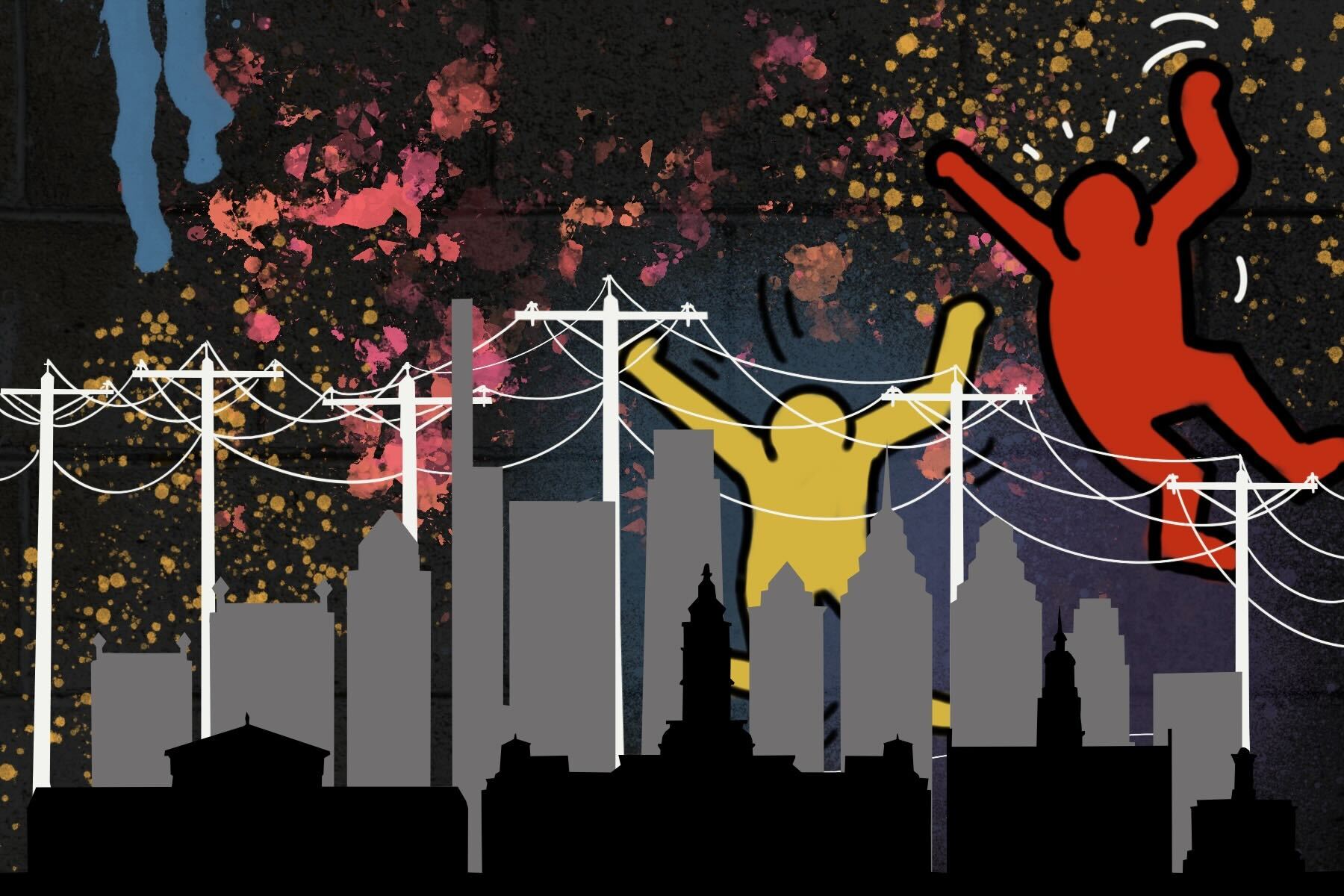Most Americans don’t know much about West Philadelphia. As a working-class inner-city enclave, it is not the type of neighborhood that garners much nationwide attention. The only thing most people know about the area is its mention in the introduction to “The Fresh Prince of Bel-Air,” where a young Will Smith shoots hoops on a basketball court ringed by boarded-up row houses. Smith, who plays a fictionalized version of himself on the show, grew up in West Philadelphia and has remained close to the community that shaped his career.
In June 2018, Smith received a tribute that has been gifted to only the most beloved of the city’s stars. Painted across the side of a warehouse on Girard Avenue is a four-story tall mural of Smith, fancifully dressed in a suit and Air Jordans, staring out toward the charter school down the block. Rendered in the style of Kehinde Wiley’s presidential portrait of Barack Obama, it is a depiction of strength and resolve in an area that has looked toward its greatest star as an example of success. The mural is a shrine to one of West Philadelphia’s most prolific residents, yet it is a monument to much more. Its location and artistry are part of a long story of urban decay and rebirth, a tale that is more than a hundred years in the making.
American city planners at the turn of the 20th century faced an immense dilemma. Looking out across major cities plagued by deteriorating housing, worsening public health and civil unrest, those in administrative positions decided that change was needed. The collective realization birthed the City Beautiful movement, a political and cultural campaign to improve American cities by cleaning out cramped, unsafe areas and providing greater access to resources that improved a citizen’s quality of life. City governments demolished deteriorating housing, cleared out slums and built sprawling parks, once again making America’s metropolises desirable places to call home.
Through the 1940s and 1950s, American cities were as bustling and thriving as ever, until a series of factors including the growing automobile industry and increasingly predatory zoning policies accelerated the processes of white flight and urban decay, robbing these cities of their economic cores. The 1970s and 1980s saw rising crime rates and heightened political corruption, processes that only accelerated urban blight. Many American cities have never recovered from this slump, and while crime rates have fallen and incomes have risen, many cities still bear the scars of this dark chapter.
Today, the quality of life in American cities is measured based on metrics such as the violent crime rate, quality of housing stock and income equality. Philadelphia is one of the cities that oftentimes finds itself on the undesirable ends of these lists. Once the financial epicenter of a newly formed United States and then a pioneer of industry, the current state of Philadelphia is indicative of the economic trends that have transformed many American cities from thriving hubs to decaying husks. The city of over a million and a half people experienced many of the most destructive factors of urban decay in their most extreme forms, and today the city is home to some of the most resource-deprived neighborhoods in the country.
Among the many problems the city struggled with at the end of the 20th century was vandalism in the form of widespread graffiti. Graffiti came into vogue in the 1970s, spraypainted onto abandoned buildings and subway cars by an inner-city youth population whose schools and extracurricular programs failed to offer traditional artistic outlets. It was both a form of self-expression for underprivileged youth and a scourge in the eyes of the city, so much so that Philadelphia mayor Wilson Goode formed an Anti-Graffiti Network in 1984 to remove the works and stamp out perceived delinquent tendencies.
The network was initially focused on curbing the prevalence of graffiti, but over time it developed a softer touch, transforming into a forum for community discourse about public art, which often included mural making. The popularity of some early murals, such as the famous portrait of Philadelphia 76ers star Julius Erving, led to the rebranding of the Anti-Graffiti Network as the Mural Arts Program in 1997.
The Mural Arts Program offers a radical approach to urban redevelopment. Premised on the empowerment rather than the shunning of young people, it employs artists, some of them native Philadelphians, to paint sprawling murals on warehouses, row houses and just about any other large surface in the city. Taking a less punitive approach to vandalism, the program runs youth arts groups that work with the demographic most likely to partake in graffiti to redirect their creativity toward the making of public art. In addition to engaging the curiosity and imagination of the city’s young people, the resulting murals also provide beauty to resource-deprived areas that have derelict streets and buildings. The City Beautiful movement often cast aside the ruins of urban decay; the Mural Arts Program is restoring them.
An essential component of Philadelphia’s murals is the scenery that surrounds their environments. The works are oftentimes painted onto the sides of row houses or abandoned factories overlooking vacant lots with overgrown grass, located in these places for the open space they afford. Their sites are not only chosen for their convenience but because these locations speak to the gritty, authentic character of the city. Murals often depict a reality that is disconnected from the present, and sitting them in locations that ground the viewer in the material reality of the city is crucial to the experience of consuming public art.
Over 4,000 murals adorn the streetscapes of Philadelphia, and while the sheer scale of the program is commendable, there are several notable examples of works that best speak to the program’s purpose. An important function of public art is to show life as it could be, even if this idealized vision seems impossible. “Peace Wall” is a mural in the Gray’s Ferry neighborhood depicting people of all racial backgrounds placing their hands atop each other.
At the time of the mural’s painting, Gray’s Ferry was notorious for its high racial tensions. The mural was painted at a time when the community was anything but harmonious, yet in the 25 years since its completion, the neighborhood has changed significantly and become a more relaxed community. “Garden of Delight” is another mural that shows the city in a romanticized capacity, depicting a sea of lush greenery that is at odds with the concrete expanse around it. Some murals show life through an optimistic lens, but visual art is also about celebrating life as it really occurs. “Common Threads” depicts young Philadelphians adopting the poses of the subjects of Renaissance paintings, offering a creative twist on the portrait form. Though there is a fantastical quality to the mural, it is also a mirror held up to the people of the city, allowing themselves to be seen in the beauty of art.
Public art is inherently reflective of a community, yet the individual artist plays a large role in determining its presentation. The Mural Arts Program is respected for its efforts to thoroughly involve members of underserved communities in the process of creating art, and there is undoubtedly some merit to this point. The program’s stat sheet touts the nearly $3 million invested in the city each year and the over 2,000 students who participate in its youth art groups. However, these facts alone do not paint the full picture. It is important to look at who is painting the murals to understand where the program does not always live up to its aspirations.
Despite its stated goal to empower low-income members of the Philadelphia community, many of the artists commissioned for the murals are city transplants or affluent, established artists that dictate to the communities what art should adorn the streets. The painter who rendered Smith in West Philadelphia was born in London. Meg Saligman, who painted “Common Threads,” is from upstate New York. These artists, who bring their own ideas to the table when they are hired, are essentially speaking for the community, a minimizing act not entirely unlike the condemnation of the graffiti art that once lined the city’s streets. Most muralists do not take on the work with bad intent and seek to accurately capture the spirit of their selected neighborhood, yet there is an inherent imbalanced relationship between artist and muse.
The history of murals in Philadelphia is distinctive, yet murals are certainly not unique to the city. Many U.S. cities such as Chicago and Los Angeles have undertaken mass mural programs based upon the success of the Mural Arts Program. Even in cities where coordinated programs are lacking, murals still adorn the sides of many buildings. Philadelphia can take substantial credit for the popularization of murals as an urban art form, demonstrating that even when brought about in imperfect conditions, the works have the ability to transform the way people perceive their environment.

















